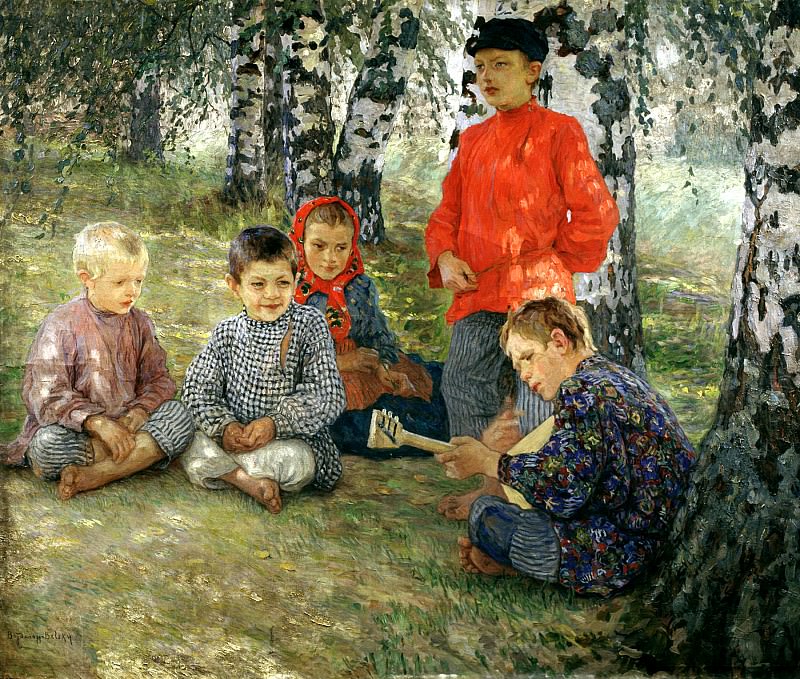Bogdanov-Belsky Nikolai – Virtuoso 900 Classic russian paintings
Bogdanov-Belsky Nikolai - Virtuoso
Edit attribution
Download full size: 1800×1527 px (1,3 Mb)
Back to album: 900 Classic russian paintings
Nikolai Bogdanov-Belsky devoted all his creativity to the simple village children. He didn’t just love them, he knew them, understood them, felt them, because this academician himself was just as much a barefoot village boy in his childhood. He had no father, he was illegitimate. And his mother struggled too hard and too much with poverty to pay special attention to the boy - she had no time. Kolya worked himself - herding cattle in the summer days.
Description of the painting "Virtuoso" by Nikolai Bogdanov Belsky
Nikolai Bogdanov-Belsky devoted all his creativity to the simple village children. He didn’t just love them, he knew them, understood them, felt them, because this academician himself was just as much a barefoot village boy in his childhood.
He had no father, he was illegitimate. And his mother struggled too hard and too much with poverty to pay special attention to the boy - she had no time. Kolya worked himself - herding cattle in the summer days. But in winter the boy studied.
Fortunately, he met such a wonderful teacher who not only managed to spot the great talent in an ordinary boy, but did everything to ensure that the boy’s talent is not lost.
The picture "Virtuoso" shows a flock of children who enthusiastically listen to the little musician. The virtuoso himself is fascinated by his playing, his eyes closed and his eyebrows furrowed... It’s clear that the boy wasn’t involved with conservatories and music schools, most likely the boy had learned to play himself. But he has mastered this difficult science, otherwise the children would not be sitting around him watching him play.
The children’s faces are bright and clean. Each face has its own character, its own little story. Here is a bright boy - the sounds of the instrument for him a real miracle. Of course, the village children have seen a balalaika, but when your friend plays it, it is a real wonder. So he keeps his eyes on the skillful hand of the little virtuoso.
The dark boy - he likes the game. So does the performance, but... But what if the virtuoso makes a mistake, could that be? That’s the expression written on the boy’s sly face.
The girl in the red kerchief just listens to the tune, and a smile appears on her face.
An older boy stands and looks thoughtfully into the distance - the music has brought something to his mind. Apparently, the little musician is indeed a virtuoso, if he makes his friends and us, the admirers of Bogdanov-Belsky’s works, think.
Кому понравилось
Пожалуйста, подождите
На эту операцию может потребоваться несколько секунд.
Информация появится в новом окне,
если открытие новых окон не запрещено в настройках вашего браузера.
You need to login
Для работы с коллекциями – пожалуйста, войдите в аккаунт (open in new window).




















COMMENTS: 10 Ответы
Россия
Вторая половина XIX века
Виртуоз. 1891
Холст, масло.
Национальный музей Грузии
великолепное мастерство художника, не могу насмотреться, просто заворожена!
"... И Родина щедро поила меня берёзовым соком... "
картины завораживают
Напишите пожалуйста описание к данной картине
Щазз
напешите
очень хорошая картина
люблю рассматривать лица, взгляды, воображать, как сложатся судьбы персонажей. У мальчика в красном цепкий взгляд, прагматичный
Когда её написали?
You cannot comment Why?
In the foreground, one boy is seated, playing a stringed instrument that resembles a balalaika. His gaze is focused on his hands as he plays, suggesting a moment of concentration and perhaps a performance. To his left, two other boys are seated, one with blonde hair and the other with darker hair, both looking towards their peer playing the instrument. The boy with darker hair has a slight smile, indicating enjoyment.
Behind these boys, a girl in a red headscarf and a boy in a bright red shirt and a black cap stand or sit, observing the scene. The boy in red appears to be looking out towards the viewer, or perhaps at something beyond the frame. The overall atmosphere is one of youthful innocence and shared simple pleasure. The sunlight filters through the leaves of the birch trees, creating dappled light and shadows on the ground, adding to the natural and tranquil ambiance of the scene.
The subtext of the painting likely relates to themes of childhood, rural life, community, and the simple joys of leisure and artistic expression. The title, Virtuoso, humorously refers to the boy playing the instrument, elevating a common childhood pastime to a more formal artistic endeavor. It speaks to the natural talents and budding creativity that can be found even in the simplest of settings. The scene celebrates the beauty of informal gatherings and the way music and shared moments can bring children together.